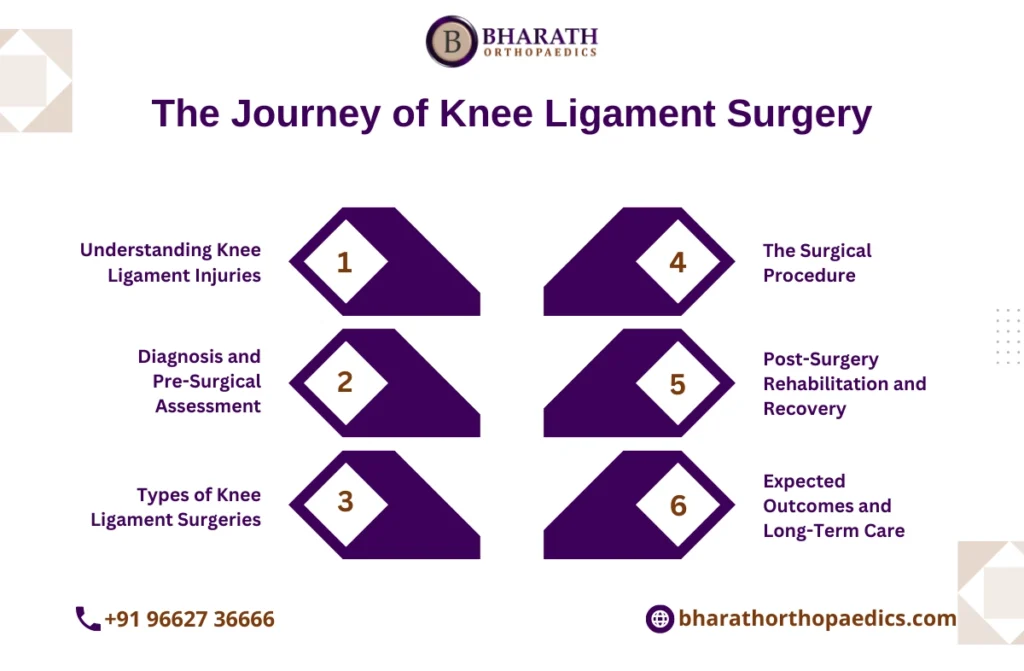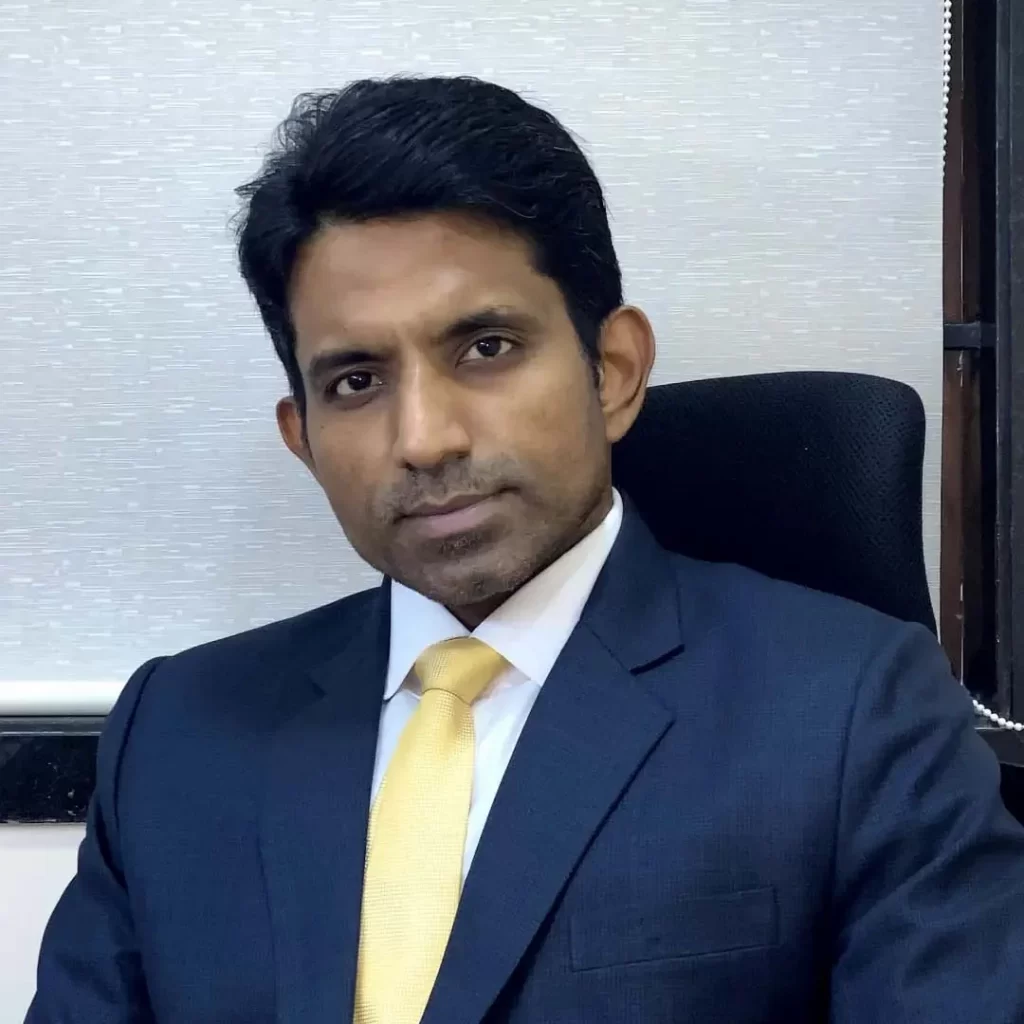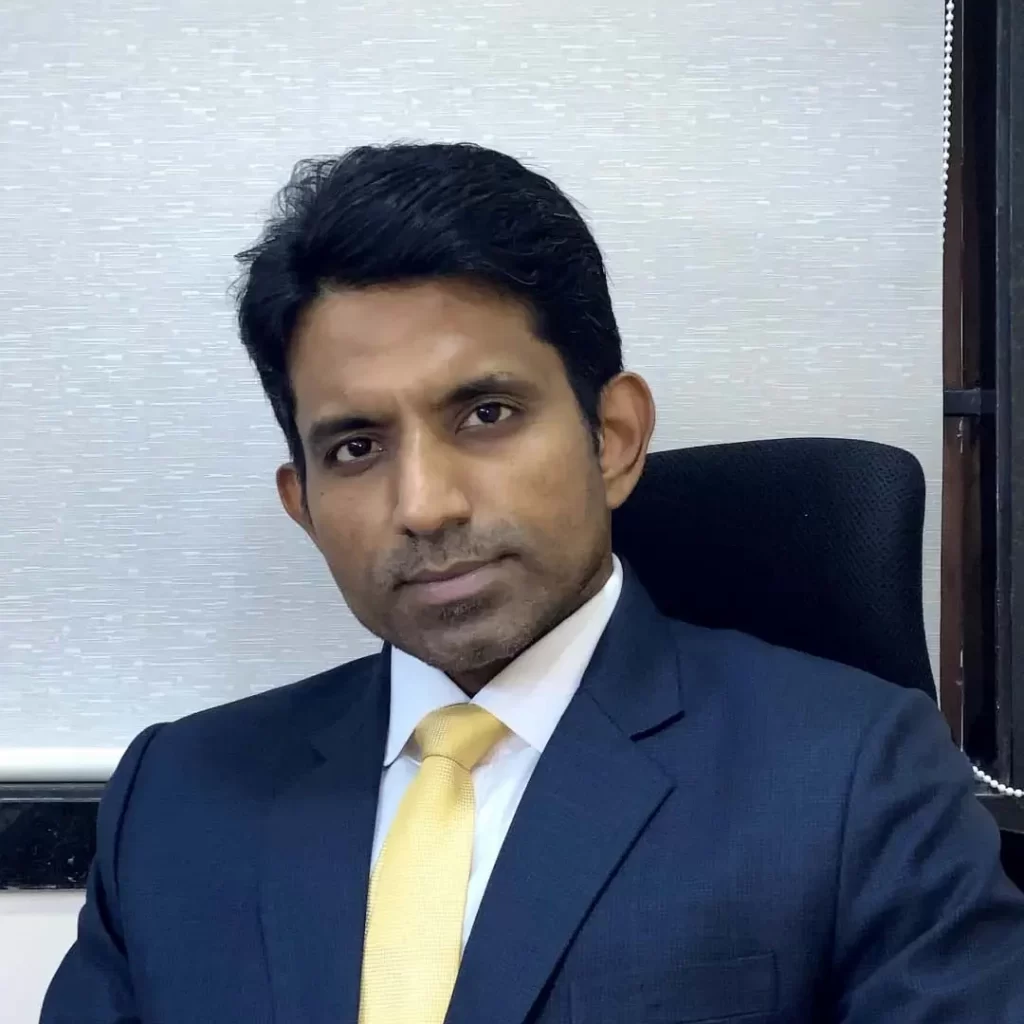Knee ligament surgery in Chennai typically involves an arthroscopic procedure, which is a minimally invasive surgical technique that allows the surgeon to access the knee joint through small incisions. The surgeon will use a small camera and specialized instruments to repair or reconstruct the damaged ligament.
Ligaments (Knee Ligament Surgery) are elastic tough bands of fibrous tissue that connect bones and provide stability and strength to the joint. A flexible band of tough fibrous connective tissues connects two bones or cartilages to strengthen the joints.
They conjointly provide support to limit the joint’s movement. Ligaments are often damaged typically in a sports injury where the knee joint becomes unstable. A torn ligament severely limits knee movement. This ends up in the incapability to turn or twist the leg.
If medical treatments are not convincing, ligament repair surgery may be an effective treatment. Replacing the ligament with a piece of healthy connective tissues or the tendon to correct a torn knee ligament is involved. The connective tissues that unite a muscle with some other parts are the tendons.

Ligaments in the Knee
Ligaments play an important role in keeping the knee stable and enabling a person to have a full range of active movement. There are about four main ligaments in the knee which include:
- An Anterior Cruciate Ligament (ACL) – Helps to control the rotation and forward movement of the shin bone – which is in front of the leg below the knee and is located in the center of the knee.
- A Posterior Cruciate Ligament (PCL) – Is located in the center of the knee to control the backward movement of the shin bone.
- Medial Collateral Ligament (MCL) – It gives stability to the inner knee.
- Lateral Collateral Ligament (LCL) – This gives stability to the outer knee.
Risks of Knee Ligament Surgery
Knee ligament surgery, while generally safe and effective, carries certain risks, including:
- Infection: Despite sterile techniques, there’s a small risk of infection at the surgical site.
- Blood Clots: Deep vein thrombosis (DVT) can occur, particularly in the legs.
- Stiffness: Postoperative stiffness or limited range of motion may develop.
- Nerve or Blood Vessel Damage: Although rare, nerves or blood vessels around the knee may be injured.
- Graft Failure: The reconstructed ligament may fail, requiring further surgery.
- Chronic Pain: Persistent pain around the knee can occur post-surgery.
- Anesthesia Risks: Complications from anesthesia, including allergic reactions or breathing problems, may arise.
Causes of Knee Ligament Injuries
Knee ligament injuries typically occur due to:
- Sports Injuries: High-impact sports like football, basketball, and skiing often lead to ligament tears.
- Sudden Movements: Abrupt stops, twists, or changes in direction can strain or rupture ligaments.
- Trauma or Accidents: Vehicle collisions or falls can severely damage the knee’s ligaments.
- Degeneration: Age-related wear and tear may weaken ligaments over time, making them prone to injury.
If you experience knee pain, instability, or swelling, consulting a specialist for Knee Ligament Repair Chennai is crucial for timely intervention.
Benefits of Knee Ligament Surgery in Chennai
Knee ligament surgery offers several benefits, including:
- Restored Stability: Reconstructing torn ligaments enhances knee stability, reducing the risk of further injury.
- Improved Function: Surgery can significantly improve knee function, allowing for a return to normal activities and sports.
- Pain Relief: It alleviates chronic pain caused by ligament damage.
- Enhanced Quality of Life: Improved mobility and function lead to a better overall quality of life.
- Prevention of Further Damage: Surgery can prevent additional knee damage and degeneration.
- Increased Strength: Rehabilitation post-surgery helps in regaining knee strength and endurance.
Best Knee Ligament Surgeon in Chennai
Dr. L. Bharath
Dr. L. Bharath is widely recognized as one of the Best Knee Ligament Surgeons in Chennai. Known for his exceptional skills in orthopedic surgery, Dr. Bharath specializes in knee ligament reconstruction and repair, utilizing advanced techniques and technologies to ensure optimal outcomes. His extensive experience in performing complex knee surgeries, combined with a patient-centered approach, makes him a top choice for those seeking high-quality orthopedic care. Dr. Bharath’s expertise, along with his commitment to using the latest surgical methods, has earned him a reputation as a leading specialist in Knee Ligament Surgery in Chennai.
- Available Time: Mon-Sat 9:30 am to 8 pm | Sun – 10 am to 3 pm
- Address: Flat-A Ground Floor , Balaji Villa, New Door No.38/1, Old Door No.9/1, Rajaratnam Street, Kilpauk, Chennai-600010

Knee Ligament Reconstruction Surgery Process
- Pre-Surgery Preparation: Before undergoing Knee Ligament Surgery in Chennai, patients undergo a detailed evaluation, including imaging studies like MRI to assess the extent of ligament damage.
- Surgical Procedure: The surgeon replaces the torn ligament with a tissue graft, either from the patient’s own body or a donor, ensuring stability and function of the knee joint.
- Minimally Invasive Techniques: The Best Knee Ligament Surgeon in Chennai often uses arthroscopy, a minimally invasive technique, to reduce recovery time and scarring.
- Post-Surgery Rehabilitation: After the surgery, a structured rehabilitation program is essential for regaining strength, flexibility, and full function of the knee.
- Follow-Up Care: Regular follow-ups are crucial to monitor healing and ensure the success of Knee Ligament Surgery in Chennai.
Prevention of Knee Ligament Injury
Preventing knee ligament injuries involves several strategies:
- Strength Training: Strengthen the muscles around the knee, especially the quadriceps and hamstrings.
- Flexibility Exercises: Maintain flexibility through regular stretching of the leg muscles.
- Proper Technique: Use correct techniques in sports and physical activities to avoid undue stress on the knees.
- Adequate Warm-Up: Always warm up before engaging in physical activities.
- Wear Proper Footwear: Use shoes that provide adequate support and fit well.
- Use Braces or Supports: Consider wearing knee braces or supports during high-risk activities.
- Balance and Agility Training: Improve balance and coordination through exercises that enhance stability.
- Gradual Progression: Gradually increase the intensity and duration of physical activities to avoid overloading the knee.
- Avoid High-Risk Movements: Be cautious with movements that involve sudden changes in direction or speed.

Knee Ligament Injury Diagnosis
Diagnosing a knee ligament injury involves several steps:
- Medical History: The doctor will ask about the injury’s cause, symptoms, and any previous knee issues.
- Physical Examination: The doctor will examine the knee for swelling, tenderness, and range of motion. Specific tests, such as the Lachman test, pivot shift test, and anterior drawer test, may be performed to assess ligament stability.
- X-rays: To rule out bone fractures.
- MRI (Magnetic Resonance Imaging): To provide detailed images of soft tissues, including ligaments, cartilage, and muscles, helping confirm the extent of the injury.
- Ultrasound: Sometimes used to assess ligament injuries.
- Arthroscopy: In rare cases, a minimally invasive procedure called arthroscopy may be performed, allowing the doctor to view the inside of the knee and confirm the diagnosis.
Early and accurate diagnosis is crucial for determining the appropriate treatment and ensuring the best possible recovery.
Conditions Treated by Knee Ligament Reconstruction Surgery
- ACL Tears: Knee Ligament Surgery in Chennai is most commonly performed to repair anterior cruciate ligament (ACL) tears, often caused by sports injuries.
- PCL Injuries: Posterior cruciate ligament (PCL) injuries are less common but can also require reconstruction to restore knee stability.
- MCL and LCL Injuries: Medial collateral ligament (MCL) and lateral collateral ligament (LCL) tears are treated by the Best Knee Ligament Surgeon in Chennai to prevent long-term joint instability.
- Combined Ligament Injuries: Complex injuries involving multiple ligaments may necessitate a more extensive Knee Ligament Repair in Chennai.
- Chronic Instability: Patients with chronic knee instability, often due to untreated ligament injuries, can benefit from Knee Ligament Surgery in Chennai to restore normal knee function.
Procedures for Knee Ligament Surgery
Knee Ligament Surgery in Chennai utilizes cutting-edge techniques tailored to the injury’s severity. Common procedures include:
- Arthroscopic Surgery: Minimally invasive and highly precise, knee surgery arthroscopy in Chennai is popular for ligament repairs. A small camera guides surgeons, ensuring minimal tissue damage and faster recovery.
- ACL Reconstruction: For anterior cruciate ligament (ACL) injuries, surgeons replace the torn ligament with a graft. This graft is often taken from the patient’s hamstring or patellar tendon.
- PCL Surgery: Posterior cruciate ligament (PCL) injuries are less common but require reconstruction if torn.
- Collateral Ligament Repairs: Injuries to the medial collateral ligament (MCL) or lateral collateral ligament (LCL) often involve suturing or grafting for stability.
Understanding the knee ligament surgery cost is essential, as it can vary based on the procedure, hospital, and surgeon expertise.
Recovery and Rehabilitation
Post-surgery recovery is critical for regaining strength and mobility. Key steps include:
- Initial Recovery (0–2 Weeks): Pain management and rest. Use crutches to avoid weight-bearing on the affected leg.
- Physical Therapy (2–6 Weeks): Gradual exercises to improve flexibility and strengthen surrounding muscles.
- Advanced Rehabilitation (6 Weeks–6 Months): High-intensity exercises and functional training to restore complete knee function.
Working closely with your surgeon and physiotherapist is vital for a successful outcome. Many patients undergoing Knee Ligament Repair Chennai report significant improvements within six months.
Best Knee Ligament Surgeon in Chennai – Dr. Bharath
Dr. Bharath Loganathan is a renowned knee ligament surgeon in Chennai, known for his expertise in minimally invasive procedures. With years of experience, he has successfully treated numerous patients suffering from ligament injuries, ensuring faster recovery and improved mobility.
- Specialization: Orthopedic Surgeon & Knee Ligament Specialist
- Qualification: MBBS, MS in Orthopaedics and MRCS
- Expertise: ACL, PCL, and MCL reconstruction, arthroscopic knee surgery, and sports injury management
- Experience: +15 years of experience in performing successful knee ligament surgeries
- Success Rate: High success rates with excellent patient outcomes
Why Patients Trust Dr. Bharath?
- Specializes in ACL, PCL, and MCL reconstruction surgeries.
- Uses advanced arthroscopic techniques for minimal pain and faster healing.
- Personalized rehabilitation programs for optimal recovery.
- High success rates with satisfied patient testimonials.
- Offers treatment at leading orthopedic hospitals in Chennai.
If you’re searching for the Best Knee Ligament Surgeon in Chennai, Dr. Bharath is a trusted choice. His expertise, coupled with cutting-edge technology, ensures the best possible outcomes for knee ligament injuries.

Conclusion
Knee ligament surgery in Chennai is a highly specialized field with numerous reputable surgeons offering advanced treatments. One notable specialist is Dr. L. Bharath at Bharath Orthopedics. Renowned for his expertise in knee and hip replacement procedures, Dr. L. Bharath provides cutting-edge ligament repair and reconstruction techniques, ensuring optimal recovery and functionality. His clinic is equipped with state-of-the-art facilities and a dedicated team, making Bharath Orthopedics a top choice for patients seeking effective and personalized knee ligament surgery in Chennai.
Read also Indian Food For Strong Bones.

